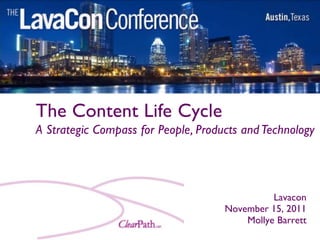LavaCon 2011: Content Life Cycle Strategic Compass
- 1. The Content Life Cycle A Strategic Compass for People, Products and Technology Lavacon November 15, 2011 Mollye Barrett
- 2. Use the Content Life Cycle The content life cycle helps identify business requirement for how content must be treated, handled and processed. Identify requirements for an end-to-end content lifecycle with a focus on roles of people, information products produced and technology currently used.
- 3. Directional Wheel www.cdgroup.com/EX2/images/Content_Lifecycle. gif
- 5. Circles in Circles http://www.langsolinc.com/cf/LANGUAGE/ContentFiles/Global%20Content%20Value%20Chain.png
- 7. Content Life Cycle Thought Leaders Authoring, Repository, Assembly, Delivery, Archive Ann Rockley, Managing Enterprise Content: A Unified Content Strategy Capture, Manage, Deliver, Store, Preserve Association for Information and Image Management (AIIM) Authoring, Repository, Assembly/Linking, Publishing JoAnn Hackos, Content Management for Dynamic Web Delivery Collect, Manage, Publish Bob Boiko, The Content Management Bible Creation, Editing, Publishing Gerry McGovern, New Thinking Production, Delivery Tony Byrne, CMS Report
- 8. About the CLC for a Unified Content Strategy One Technical Publications team with 20 writers covering 14 products used 48 tools to produce PDF, HTML and HTML Help. Learn what every content creator does in the course of their normal day. Not everyone views their work in the same way, Work with a group to determine how they see their work.
- 9. CLC Workshop ŌĆó Identify how focus content is treated, handled and processed. ŌĆó Listen for problems. Look to optimize activities. More than authoring and publishing. ŌĆó Use workshop as a change management opportunity; let people know what is coming. Frame business process with the content lifecycle, not software functionality ŌĆó With information gathered, develop an impromptu content life cycle. Discovery presents opportunities for automation, areas of workflow improvement, ways to measure cost and a way to make a tacit technical publication process explicit. ŌĆó Understand projects and prepare for a content management system. Know what to look for!
- 10. Workshop: Products, Tasks, Tools Product Tasks Tools
- 12. Products: Reuse
- 13. Products: Reuse, One Audience
- 14. Products: Reuse, 17 Audiences
- 15. CLC Workshop: Tasks automate workflow/reports track/attributes/conrefs IA role SME SME conversion conversion research reuse reuse troubleshoot troubleshoot reviews reviews style sheets add structure workflow/reports workflow automate style web design web design plan/replan plan/replan peer reviews peer reviews edit rebrand rebrand workflow workflow transforms/workflow automate post post usability manage manage proof publish publish documents documents design version control IA role add role quality system system content track track scripting scripting analysis control admin admin add structure DITA workflow/reports metrics SVG graphic graphic organize organize structure structure herd/nudge herd/nudge estimate estimate tweaking tweaking IA role queries queries meetings
- 16. CLC Workshop: Tools Rename Tumblr SharePoint CMS WinMerge CMS Paint utility RoboHelp Wordpad/ HTML Help DITA OTK Snagit Camtasia SQL capture Notepad Workshop oXygen DITA OTK CMS/Web Flash ePublisher Confluence Perl CMS Shared View oXygen services Develop CMS ANT CMS JAVA CMS Saxon CMS RenderX CMS Inset Plus DITA OTK Subversion CMS TextCrawler Snagit Visio DITA OTK CMS DITA OTK DITA OTK DITA OTK DITA OTK WebWorks FrameMaker WIN Grep CMS AXCM RoboHelp oXygen oXygen oXygen oXygen DITA OTK Flare Acrobat oXygen
- 17. Workshop Content Life Cycle
- 18. Published Content Life Cycle
- 19. Published Content Life Cycle: Roles
- 21. CLC Results ŌĆó Identified business requirements: personas and unified content ŌĆó How content is treated, handled and processed: removed content silos and publish from one source across products ŌĆó End-to-end content lifecycle: include published model that supports Web Help, HTML Help, PDF ŌĆó Focus on roles: ŌĆó People ŌĆō writers, information architect, system admin ŌĆó Information products ŌĆō Online Help, User Guide, Admin Guide, Forms Guide, Install Guide, Function Guide, Quick Reference Guide, Form Builder, Report Builder ŌĆó Technology ŌĆō Frame, Flare and RoboHelp to DITA with automated publishing, 17 audiences for all information products.
- 22. Discussion Mollye Barrett ClearPath, LLC mollye@clearpath.cc






















